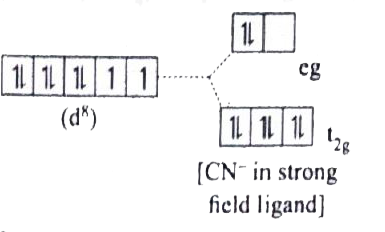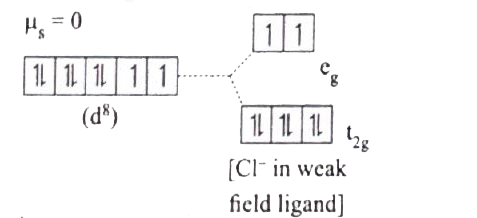[Ni(CN)4]2− is diamagnetic , while [NiCl4]2− is paramagentic, explain using crystal field theory.
Text Solution
(a)[Ni(CN)4]2−
Ni=3d84S2
Ni2+=3d8

Nature of the complex-Low spin (Spin paired)
Ligand filled electronic configuration of central metal ion, t62ge2g
Magnetic property : No unpaired electron (CN− is strong filled ligand ), hence it is dimagnetic.
Magnetic moment : μs=0
(b)=[NiCl4]2−
Ni=3d84S2
Ni2+=3d8

Naute of the complex,-high spin
Ligand filled electronic configuration of central metal ion , t62ge2g
Magnetic property : Two unpaired electron (Cl− is weak field ligand). Hence it is paramagnetic
Magnetic moment : μs=√2(2+2)
=√8=2.83BM
|
Topper's Solved these Questions
- COORDINATION CHEMISTRYBOOK - FULL MARKSCHAPTER - COORDINATION CHEMISTRYEXERCISE - Additional Question(Choose the correct answer)
76 Videos
- COORDINATION CHEMISTRYBOOK - FULL MARKSCHAPTER - COORDINATION CHEMISTRYEXERCISE - Additional Question(Fill in the blanks)
64 Videos
- COORDINATION CHEMISTRYBOOK - FULL MARKSCHAPTER - COORDINATION CHEMISTRYEXERCISE - Additional Question(5 Marks Question)
26 Videos
- CHEMISTRY IN EVERYDAY LIFE BOOK - FULL MARKSCHAPTER - CHEMISTRY IN EVERYDAY LIFE EXERCISE - ADDITIONAL QUESTION ( 5 Mark Questions )
2 Videos
- ELECTRO CHEMISTRYBOOK - FULL MARKSCHAPTER - ELECTRO CHEMISTRYEXERCISE - ADDITIONAL QUESTIONS -5- MARK QUESTIONS
15 Videos
Similar Questions
Knowledge Check
Give reason for the statement [Ni(CN)4]2− is diamagnetic while [NiCl4]2− is paramagnetic in nature .
AIn [NiCl4]2− no unpaired electrons are present while in [Ni(CN)4]2− two unpaired electrons are presentBIn [Ni(CN)4]2− , no unpaired electrons are present while in [NiCl4]2− two unpaired electrons are present .C[NiCl4]2− shows dsp2 hybridisation hence it is paramagnetic .D[Ni(CN)4]2− shows sp3 hybridisation hence it is diamagnetic .Give reason for the statement [Ni(CN)4]2− is diamagnetic while [NiCl4]2− is paramagnetic in nature .
AIn [NiCl4]2− no unpaired electrons are present while in [Ni(CN)4]2− two unpaired electrons are presentBIn [Ni(CN)4]2− , no unpaired electrons are present while in [NiCl4]2− two unpaired electrons are present .C[NiCl4]2− shows dsp2 hybridisation hence it is paramagnetic .D[Ni(CN)4]2− shows sp3 hybridisation hence it is diamagnetic .The complex []Ni(CN)4]2− is diamagnetic and the complex [NiCl4]2− is paramagnetic . What can you conclude about their molecular geometries ?
ABoth complexes have square planar geometriesBBoth complexes have tetrahedral geometriesC[NiCl4]2− has a square planar geometry while [Ni(CN)4]2− has a tetrahedral geometry .D[NiCl4]2− has a tetrahedral geometry while [Ni(CN)4]2− has a square planar geometry .
[Cr(NH3)6]3+ is paramagnetic while [Ni(CN)4]2− is diamagnetic. Explain, why ?
View SolutionThe complex [Ni(CN)4]2− is diamagnetic and the complex [NiCl4]2− is paramagnetic . What can you conclude about their molecular geometries ?
View Solution[Cr(NH3)6]3+ is paramagnetic while [Ni(CN)4]2− is diamagnetic. Explain why?
View Solution[Cr(NH3)6]3+ is paramagnetic while [Ni(CN)4]2− is diamagnetic. Explain why?
View Solution[Cr(NH3)6]3+ is paramagnetic while [Ni(CN)4]2− is diamagnetic. Explain why?
View Solution
